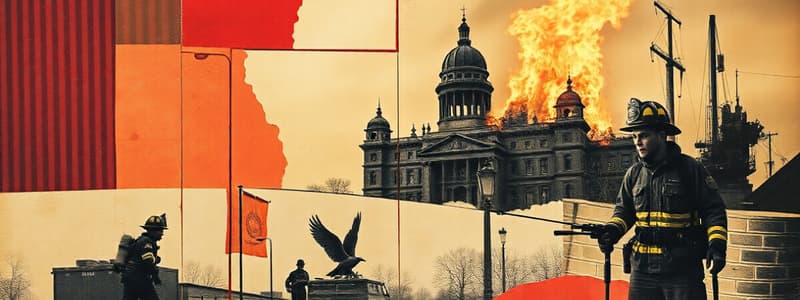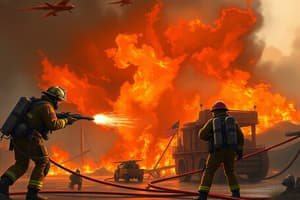Podcast
Questions and Answers
What are the two primary fireground strategies outlined in the SOG?
What are the two primary fireground strategies outlined in the SOG?
- Direct and Indirect
- Immediate and Delayed
- Proactive and Reactive
- Offensive and Defensive (correct)
Which factor is NOT considered when determining the fireground strategy?
Which factor is NOT considered when determining the fireground strategy?
- Occupancy rate of the building (correct)
- Type of construction
- Fire and smoke conditions
- Fire load
What is the primary responsibility of the Incident Commander regarding fireground strategy?
What is the primary responsibility of the Incident Commander regarding fireground strategy?
- To report incident outcomes to the public
- To ensure that no personnel enter the building
- To determine and implement the appropriate strategy (correct)
- To manage logistical support for the incident
What must the Incident Commander avoid during operations at a fire scene?
What must the Incident Commander avoid during operations at a fire scene?
When should fireground strategy management begin?
When should fireground strategy management begin?
What does the presence of an 'ALL CLEAR' benchmark indicate?
What does the presence of an 'ALL CLEAR' benchmark indicate?
What role does the Incident Commander play during a fire incident?
What role does the Incident Commander play during a fire incident?
Which of these is critical to the Incident Commander’s assessment during a transfer of Command?
Which of these is critical to the Incident Commander’s assessment during a transfer of Command?
What is the initial priority during a fire incident when exposures are present?
What is the initial priority during a fire incident when exposures are present?
When is it most effective to apply water to an exposure?
When is it most effective to apply water to an exposure?
What does 'fire under control' signify?
What does 'fire under control' signify?
What should be communicated to dispatch when defensive operations are initiated?
What should be communicated to dispatch when defensive operations are initiated?
What is necessary after commanding that the fire is brought under control?
What is necessary after commanding that the fire is brought under control?
What is the primary focus of an Offensive Fire Attack according to the guidelines?
What is the primary focus of an Offensive Fire Attack according to the guidelines?
Which of the following is NOT a consideration for fire command during an offensive operation?
Which of the following is NOT a consideration for fire command during an offensive operation?
Why must companies resist the urge to focus only on the visible fire?
Why must companies resist the urge to focus only on the visible fire?
What does the IRIC team stand for in fireground operations?
What does the IRIC team stand for in fireground operations?
What is meant by reading the smoke during fire operations?
What is meant by reading the smoke during fire operations?
What should be prioritized when assigning resources and personnel on the fireground?
What should be prioritized when assigning resources and personnel on the fireground?
In the context of fireground strategy, what is the term 'confinement efforts' referring to?
In the context of fireground strategy, what is the term 'confinement efforts' referring to?
What is a key aspect to assess before starting fire operations in an offensive strategy?
What is a key aspect to assess before starting fire operations in an offensive strategy?
What must be considered by command in relation to the fire?
What must be considered by command in relation to the fire?
Why is early ventilation important in concealed space fire attacks?
Why is early ventilation important in concealed space fire attacks?
When should command abandon marginal attacks?
When should command abandon marginal attacks?
What is a key consideration for command in attack operations?
What is a key consideration for command in attack operations?
What is the paramount action when fires involve concealed spaces?
What is the paramount action when fires involve concealed spaces?
What should command do when misjudging the position of the fire and attack efforts?
What should command do when misjudging the position of the fire and attack efforts?
In marginal fire attack situations, what is often the primary reason for operation?
In marginal fire attack situations, what is often the primary reason for operation?
What should be the approach if the fire management assessment is that the roof is unsafe?
What should be the approach if the fire management assessment is that the roof is unsafe?
What is the primary reason Command should assign a Roof Sector during marginal situations?
What is the primary reason Command should assign a Roof Sector during marginal situations?
What action is recommended if a structure cannot be safely operated in during a fire?
What action is recommended if a structure cannot be safely operated in during a fire?
What must be performed after changing from an offensive to a defensive strategy?
What must be performed after changing from an offensive to a defensive strategy?
Which option reflects the actions of crews during a change to a defensive strategy?
Which option reflects the actions of crews during a change to a defensive strategy?
What is the first priority during defensive operations?
What is the first priority during defensive operations?
What should happen to hose lines if retreat is unsafe due to them?
What should happen to hose lines if retreat is unsafe due to them?
Why is it important for Command to receive frequent updates from Sector Officers?
Why is it important for Command to receive frequent updates from Sector Officers?
What does a change to a defensive strategy indicate?
What does a change to a defensive strategy indicate?
Flashcards are hidden until you start studying
Study Notes
Fireground Strategy
- The purpose of this document is to outline fireground strategy for structure fires.
- There are two strategies: Offensive and Defensive, determined by risk management plan.
- The incident commander will choose the strategy based on several factors including:
- Building type, condition, age
- Structural integrity
- Fire load, type of fuel burning
- Fire and smoke conditions
- Rescue profile, potential for saving occupants
- The incident commander is responsible for determining and implementing the strategy.
- The primary goal of fireground strategy is safety of personnel.
- Avoiding simultaneous offensive and defensive strategies within the same fire area is crucial for safety.
- Matching the strategy to the fire conditions of the structure is paramount.
- The initial incident commander will include the fireground strategy in the scene report.
- The fireground strategy is not a mystery; all firefighters must operate within the same strategy.
Offensive Fire Attack
- An offensive fire attack is centered on rescue with the safety of firefighters as the top priority.
- An IRIC team must be assigned prior to entry.
- The initial attack line must be directed to protect rescue and escape routes for victims.
- Determining the extent and location of the fire is critical before starting fire operations.
- Command should consider the most critical direction and avenues of fire extension, speed, and their effects on:
- Rescue activities
- Risk to firefighters
- Confinement efforts
- Exposure protection
- Command must allocate personnel and resources based on the fire spread evaluation.
- A fast and strong attack is crucial to control fire and protect rescue efforts, and extinguish the fire, as it spreads in all directions, including concealed spaces such as attics.
- Early ventilation is necessary for concealed space fires, and openings should be made in the fire area.
- Command must anticipate the fire's spread and position resources and personnel accordingly.
- Protecting exposed property is crucial, particularly in the direction of fire spread.
- Attack operations involve:
- Location/position of attack
- Size of attack
- Support functions
Marginal Fire Attack
- Rescue is the only reason to operate in marginal situations.
- Command must initiate an offensive interior attack while setting up defensive positions on the exterior.
- The interior offensive attack must be constantly evaluated and abandoned if necessary.
- Command should abandon marginal attacks when:
- A primary all clear is obtained, but the situation is still marginal.
- The roof is unsafe.
- Interior forces encounter heavy heat and cannot locate the fire or make progress.
- Heavy smoke is being forced from the building under pressure and is increasing.
- Command needs to constantly evaluate conditions in marginal situations, requiring frequent reports from sector officers.
- Command should strongly consider not committing crews to the interior of a structure unless receiving a report from Roof Sector that the roof is safe to operate on.
Defensive Fire Attack
- Defensive strategy is employed when the offensive attack is abandoned due to safety concerns and the structure is conceded as lost.
- All personnel withdraw from the structure and maintain a safe distance.
- A PAR (Personnel Accountability Report) is obtained after a change from offensive to defensive strategy.
- Interior lines are withdrawn and repositioned, and hose lines may be abandoned if necessary.
- Exposure protection is the top priority in defensive operations, followed by personnel safety and then knocking down the main body of fire.
- Master streams are generally the most effective tactic in defensive operations.
- When the exposure is severe and water is limited, the most effective tactic is to put water on the exposure, potentially from the interior.
- Once exposure protection is established, attention may be directed to knocking down the main body of fire and thermal-column cooling.
- Fire under control means the forward progress of the fire has been stopped, and the remaining fire can be extinguished with the on-scene resources.
- Dispatch should record the time of the "FIRE UNDER CONTROL" report.
- Command must initiate a PAR report from all on-scene sectors and crews.
- If defensive operations are conducted from the onset of the incident, Command will notify dispatch that there will not be a primary search completed for the affected structure(s), but buildings should be searched at some point.
Studying That Suits You
Use AI to generate personalized quizzes and flashcards to suit your learning preferences.




